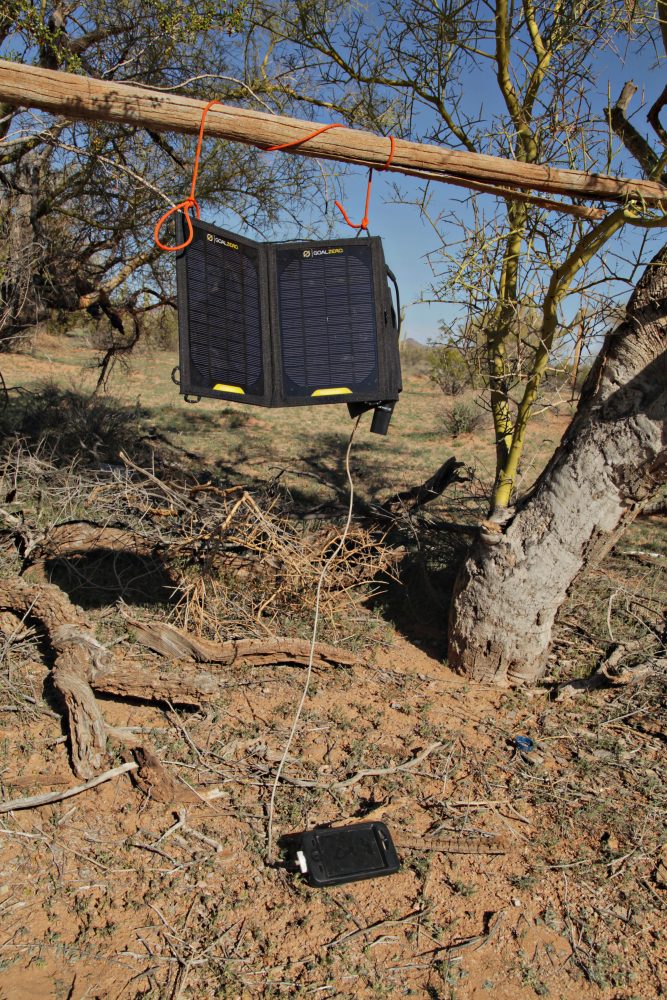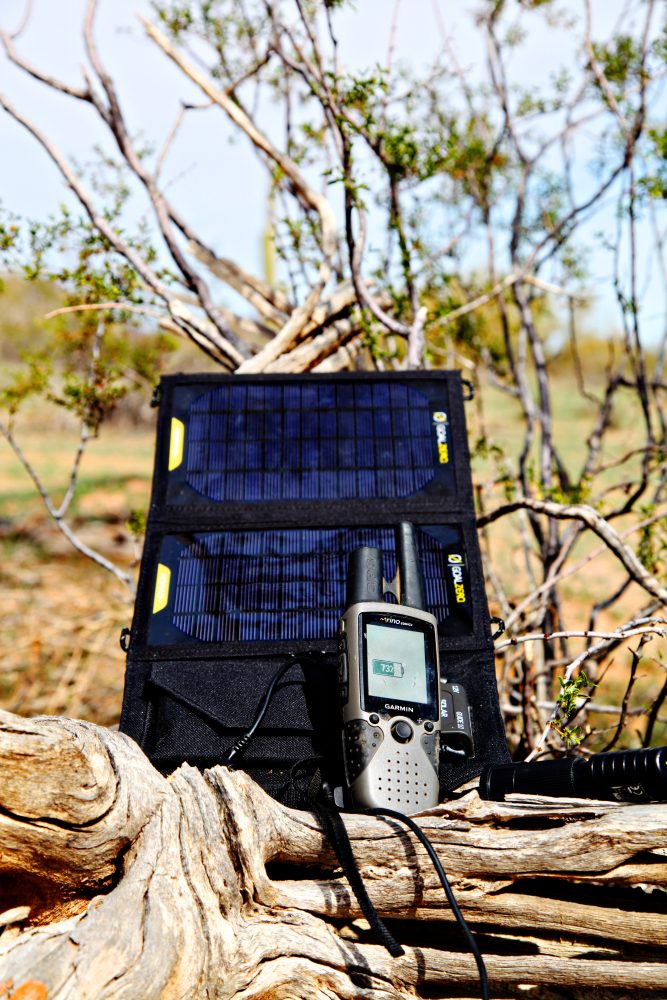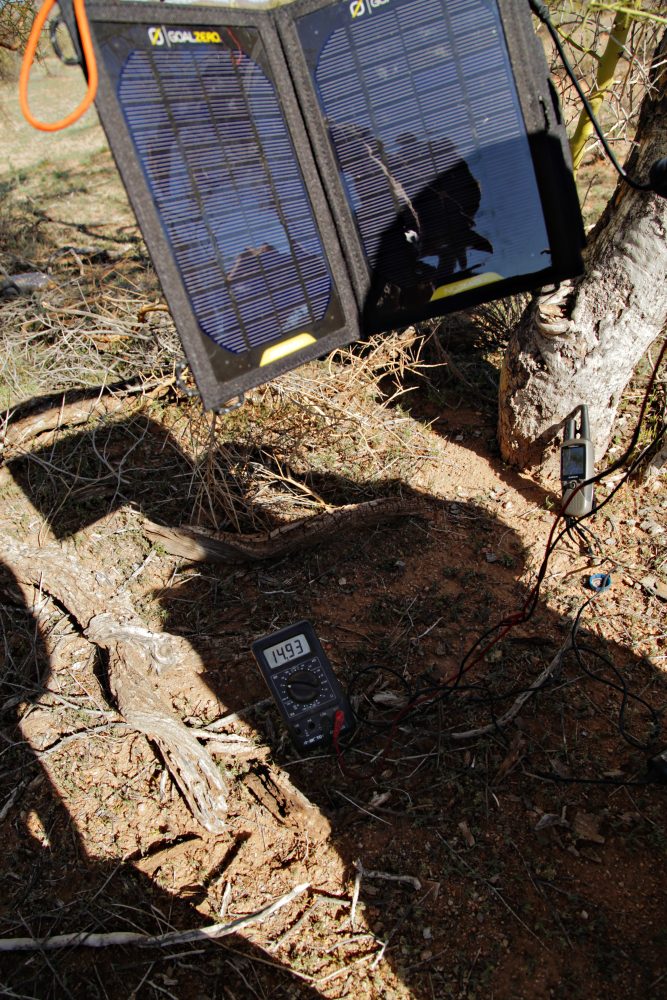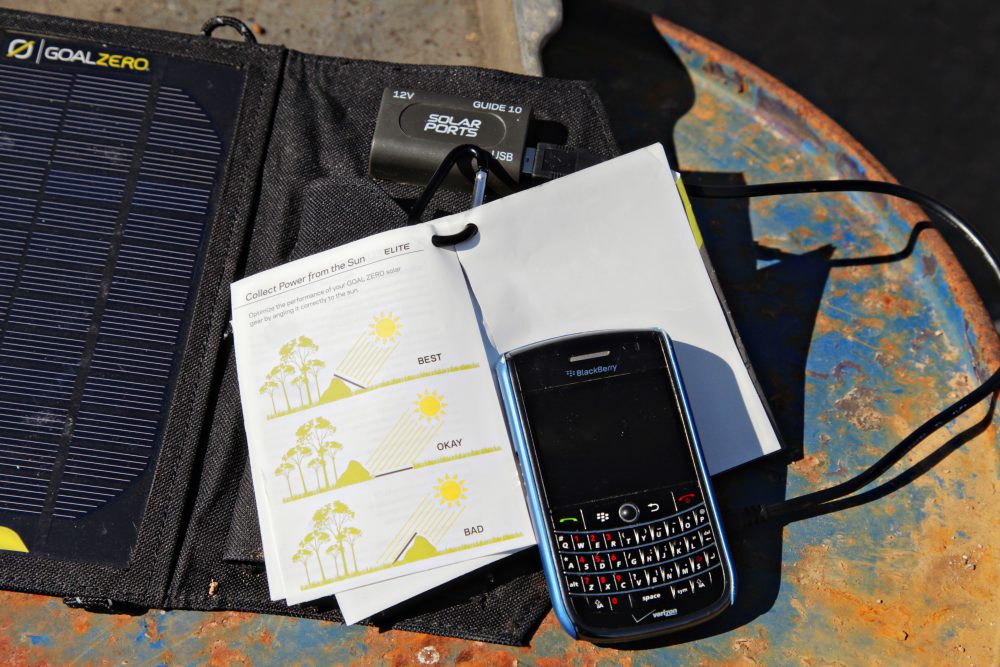Sometimes bad things happen in the wilderness, and often the best way to get out of a bad situation is by using an electronic device. Cellular and satellite phones, GPS devices and radios are among the items that come in handy when things go wrong. Along with electronic devices comes the need for electronic power. Enter the Goal Zero Nomad 7 Solar Panel.
Nomad 7 needs proper positioning for best results. It was able to charge a BlackBerry Tour in 2.5 hours of midday desert sunlight.
In February I went with my friend Paul Reithmayer and his dog Kiki to the Ironwood National Monument in southern Arizona. Paul is an expert on the Arizona border. We brought a Nomad 7 to help us with electrical power in the more remote regions. The published weight of the Nomad 7 is 0.8 pounds, but I was not backpacking, so weight was not a big consideration. The charger comes with the ability to charge through a USB port, 12-volt connector or Guide 10 connector. My particular kit also came with some rechargeable AA batteries.
Among the devices the Nomad 7 is touted to charge are smart phones, GPS devices and the Amazon Kindle. I put the Nomad 7 to the test charging each of these devices.

The instruction manual provided with the Nomad 7 is very specific about the angle of the device in relation to the sun. The panel must be positioned correctly to obtain the maximum charging ability. All my tests were conducted with the panel positioned correctly between the hours of 1000 and 1500.
The first device we attempted to charge was my nearly drained BlackBerry Tour. The Nomad 7 was able to charge it fully in about 2.5 hours. We had similar results with an iPhone. It took somewhat longer to charge an Amazon Kindle Fire. The Kindle was at 66% battery life when I started charging, and it took five hours to completely charge. In other words, the Nomad 7 performed more or less as advertised with these devices.
I ran into trouble when I tried to charge a GPS device. We were using the Garmin 530 HCX GPS/Radio combo for the trip. Despite the fact that the panel was positioned correctly and in full midday desert sunlight, it was unable to effectively charge the GPS device. We could get the device to power on, but it would not charge more than a few percentage points in the five-hour testing period. Having the ability to power up a depleted GPS device could be a lifesaver.
We were curious as to why the Nomad 7 would charge cell phones and a Kindle (albeit slowly) but not the GPS/Radio device. We measured the voltage output of the Nomad 7 at 14.93 volts at noon in the desert. If voltage were the only thing needed to charge a GPS/Radio device, then the Nomad 7 was certainly to spec. The problem is likely that the Nomad 7 puts out a respectable voltage but inadequate current.

An example of a very high voltage but low current event in your everyday life is static electricity. Revisiting Ohm’s law, voltage = current x resistance. It is estimated that the minimum voltage required to overcome the resistance of the air between your finger and an object is about 500 volts. Static electricity shocks that actually hurt can be in the area of 10,000 volts. If voltage were the important part of the equation, Mr. Rogers would have died every time he put on his red sweater. What kept Mr. Rogers alive is the fact that the current involved in static electricity shocks is so low.
We were unable to measure the current output of the Nomad 7. The USB port is advertised as having an output of 1 Amp maximum. The GPS/Radio device we were using required more current to charge than the Nomad 7 could deliver. If we had been using another GPS device, we might have been successful.
The GoalZero website shows a man wearing the Nomad 7 Solar Panel on his backpack, presumably charging a device as he walks around. Given my experience with the device in full desert sunlight and the manual’s instruction on proper use, wearing the Nomad 7 on your backpack as anything but an ornament is likely to be futile. I would have to be a very disciplined hiker to walk in a straight line with the panel lined up correctly. The Nomad 7 might work on a backpack in an old-fashioned military march, but then only if it were in correct alignment with the sun.
Another concern about the device involves my own tendency to occasionally fall down or accidentally submerge myself in swamps and rivers. The Nomad 7 is thin and lightweight, but its construction does not inspire confidence in its ability to survive much abuse. The Nomad 7 did fine while bumping around the desert in an old Dodge pickup, but I personally would not throw it in a backpack and take it to some of the places I go. I envision myself sitting down and leaning against a tree. I worry about cracking one of the panels or getting the Nomad 7 wet unless it is stowed in a plastic bag. In my personal system, it makes more sense to carry 0.8 pounds of spare batteries in a plastic bag.

The Nomad 7 is a very fun device to use. When I was able to charge my BlackBerry using only the sun, it brought a smile to my face. GoalZero makes numerous other devices that deliver more power. The Escape 150 Adventure Kit is advertised as able to run a laptop computer using a charged battery. The Extreme 350 Adventure Kit is purported to run a television for three to five hours using a charged battery. I am confident that either of those devices would be effective as emergency power in survival situations.
If you’re looking for a device to charge a cellular phone while on a long backpacking or biking trip, the Nomad 7 would probably work well. Just be aware that the device needs to be positioned correctly in full sun to be effective. I would also treat the Nomad 7 gingerly if you want to avoid damaging the unit. The suggested retail price is $99.99.
Dr. Ver Steeg is double board certified in General Surgery and Plastic and Reconstructive Surgery. He has extensive experience in trauma and wound care. In addition to having a private practice, he is the team physician for Randall’s Adventure & Training.
SOURCE:
Goal Zero
(888) 794-6250
www.goalzero.com







